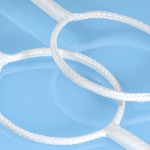21 Sep Engineer Spotlight: Cortland Biomedical’s Zachary Robbins Discusses Our 3D and Branch Braiding Capabilities
Cortland Biomedical Textile Process Engineer Zachary Robbins Discusses How Our Variation Braiding Capability Enables Greater Flexibility and Creativity in Textile Product Design
 Can you walk us through the 3D and branch braiding process?
Can you walk us through the 3D and branch braiding process?
Like normal braiding, 3D and branch braiding using a variation braider involves bobbins on a carrier going around a designated path, and strands coming together in a helical pattern. But in this case, the planning phase and the ability of the carrier path to change is unique. We use software to first determine the actual structure we’re looking for, and from there we can work on the movement of the carriers to achieve this. With a variation braider, every intersection can be a cross or pass section. This allows for an unlimited number of trials and unique possibilities.
Can you give an example of a scenario where you would recommend 3D Braiding to a prospective customer?
Typically, if a customer came to us looking for a braid that can be tied around a member and then anchored on to a point such as an artificial ligament, we would suggest doing customization and furcation to suit their needs and make it completely unique to them.
What sets Cortland Biomedical’s braiding capabilities apart?
 We are one of only a few medical-based companies in the textile sector with variation braiding capabilities. This allows us to give our customers in the medical device industry greater freedom to actualize their ideas, which will ultimately lead to cutting-edge technology breakthroughs across many surgical application areas for years to come.
We are one of only a few medical-based companies in the textile sector with variation braiding capabilities. This allows us to give our customers in the medical device industry greater freedom to actualize their ideas, which will ultimately lead to cutting-edge technology breakthroughs across many surgical application areas for years to come.
Having a variation braider gives us many specialized capabilities and great versatility for creating new textile structures. We can create robust or delicate braids, utilizing various raw materials, to create a variety of products from bulky constructs to tiny sutures.
Cortland Biomedical can create true round tubular braided structures with multiple “furcation” zones. What applications is this useful for?
This could be useful for stents or any application that uses an anchor point or conical tube reinforcement. These are areas where we’re seeing a lot of new technology emerging. A braid that is truly tubular creates negative space in the middle so you can put other things in that area, which opens a lot of new design possibilities.
You also have the ability to integrate braided eyelets into the product without the need for post-process assembly. In what scenarios is this used?
This is useful primarily for when you’re trying to create a braid and anchor it to another product, such as a medical screw or a plastic tubular device. It allows us to create an opening, place an object in, and close it. Typically, when this is done without a machine, you would need to hand fabricate each one, which would take several minutes per piece. The way Cortland Biomedical can manufacture eyelets with an automated method saves significant cost and time for our customers.
Can you tell us about the software used in variation braiding?
The software we use allows us to really customize the braid. We can change any number of characteristics, such as PPI (picks per inch) and tension, between segments of the same braid. This allows us to be much more flexible and creative to help our customers develop optimized products that are really tailored to what the surgical application necessitates.


